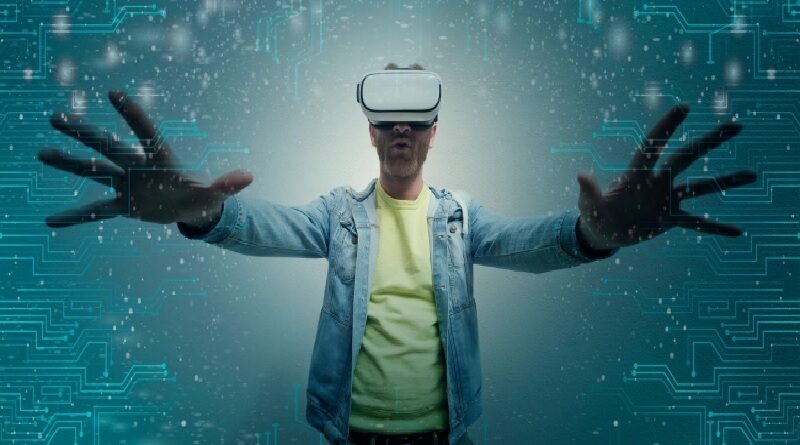Improved optics could help the metaverse become as big as the internet
the metaverse expected to reach $800 billion in revenue through social media ads, as well as hardware, software and live entertainment opportunities over the next two years, there is a need for significant hardware improvements today for realistic visual experiences tomorrow.
The concept of living in a world that is digitally created has been portrayed in countless Hollywood films depicting people who want to escape reality and dive into an alternate universe. Until recently, this virtual world was commonly thought of as a vehicle for more immersive gaming experiences, but now the concept around a metaverse has evolved drastically into a massive opportunity for wealth and companies are already starting to invest in it.
The metaverse conversation intensifies
As the year 2021 came to a close, one letter written by then Facebook, now Meta’s founder Mark Zuckerberg, sparked a worldwide conversation around the future of immersive technology and what is possible in the metaverse. In the announcement, Zuckerberg discussed how in the company’s reimagined platform, people will be able to do almost anything.
Get together with friends and family, work, learn, play, shop, create you will be able to teleport instantly as a hologram to be at the office without a commute, at a concert with friends, or in your parents’ living room to catch up,” Mark Zuckerberg Meta CEO and chairman
Still, many are left with questions about what the metaverse exactly is and how it would or could impact everyday lives. Though it can often mean different things to different people, the metaverse is a shared virtual space and the coalescence of digital and physical realities. The New York Times recently described the metaverse as a “virtual reality and digital second life [where] we would spend lots of time interacting with our friends and colleagues in virtual space we would spend money there, too.”
It’s important to note that the metaverse can only be realized through the technology that enables it. Augmented Reality (AR) and Virtual Reality (VR) offer the primary link to entering this alternate universe. With AR technology, users are operating a device that is essentially a lightweight, handheld or hands-free, immersive, and wearable computer.
Magic Leap’s tech specs, for example, offer a wide 50-degree Field of View (FoV), high resolution with 1.3m pixels per eye, superfast 120Hz refresh rate, and support over 16.8m colors. And with their new Magic Leap 2, which will be released later in 2022, even more enormous improvements of numerous parameters can be envisioned. AR glasses and their handheld controllers are best used for individuals or teams to work productively in the real world augmented by high-quality simulation. With VR technology, on the other hand, users are thrust into the digital world in a 3D experience that feels lifelike through advanced headsets and controllers. For example, Valve’s hardware utilizes visual, audio, and ergonomic technologies to create a captivating experience for users that includes optimization for FoV, dual-element lenses, canted optics, and long-session comfort.
In the European Union, 10,000 new jobs related to the metaverse are reportedly expected to be introduced by 2026 to help build the new computing platform. Digital spaces where people can visit places and meet other avatars are also being sold for massive amounts, with one virtual real estate plot most recently purchased for $2.4 million in cryptocurrency. The conversation does not end on virtual land either. Just shy of the start of 2022, a three-story yacht that exists only in the metaverse was also bought for $650,000, complete with a DJ booth, hot tubs and two helipads. Though the metaverse does have the power to be riskier than social media often can be, such as through the ease of misinformation or deep fakes, it is very possible that it also has the potential to become something that people quickly become dependent on and a technology that is quite difficult to live without.
Current setbacks of legacy devices in digital spaces
It’s evident that the metaverse will heavily impact the economy and our lifestyles as its adoption becomes more prevalent. In fact, it’s already here with games like Fortnite, which had well over 350 million users already registered in 2020 and the most recent $68.7 billion news from Microsoft announcing its acquisition of Activision Blizzard Inc. at the start of 2022. Bloomberg estimates that the market size for the metaverse could reach $800 billion in revenue through social media ads, hardware, software and live entertainment opportunities over the next two years.
However, in order for the metaverse to become truly beneficial for users in private and professional realms, there is a need for significant hardware improvements for realistic visual experiences. Traditional hardware like cell phones and computers do not offer the feeling resulting from innovative hardware and there are a variety of optical design challenges that need to be addressed to meet the technology needs of the metaverse. Today, though many people are certainly glued to their phones, most are not interested in holding up a tiny screen at eye level for an extended period of time.
With the advancements of projection systems, optic sensors, AI, spatial light modulation and precision mechanics, cutting-edge technology is required. With AR glasses, VR goggles or haptic gloves, the virtual world feels real and is directly in front of you compared to the use of phones, where AR can be realized only in a tiny field of vision and lacks a haptic feeling. With new optical electronic technologies and applications like advanced sensing, which is important for gesture recognition, and displays that allow the transformation from the real world into the virtual world and for visualizing content, more realistic interactions inside the metaverse are possible.
The evolution of Holographic Optical Elements (HOEs) also creates a more realistic and impressive experience because of their lightweight, thin form factor, and low cost in 3D displays. Legacy devices lack the ability to provide impactful connections between digital and physical worlds that are seamless and interchangeable.
Hardware innovation for a future inside the metaverse
The future unquestionably includes technology that will always be evolving. While the software is nearly there, manufacturers that are a one-stop-shop and have the experience in creating new and inventive hardware will allow companies to overcome many of the hardware obstacles expected in order to enter the metaverse with innovative glasses.
It’s critical to collaborate with a trusted manufacturing partner that has established global experts in optical systems and technologies in the development of these innovations. Access to the metaverse is also a challenge as there is a need for AR/VR solutions that are affordable to billions of people. This requires a well-established understanding of engineering, design, and manufacturing to provide complex optical and cost-effective solutions in high volume.
The significance of the hardware’s compact form factor, accurate adaptation of the Field of View (FoV), high resolution, and wider FoV needs begin on the manufacturing floor with precise optical alignment. To satisfy the viewer, an ultimate experience will be hardware that offers comfort through social ability, visual perception and wearability, as well as immersion through resolution, gestures and haptic interactions.
With the right enhancements in optics technology, sensing and display, the metaverse will likely become as big as the internet in the future. And, with over half of the world’s population, or more than 4.5 billion people, estimated to have access to the internet, it’s a lofty but plausible goal.




